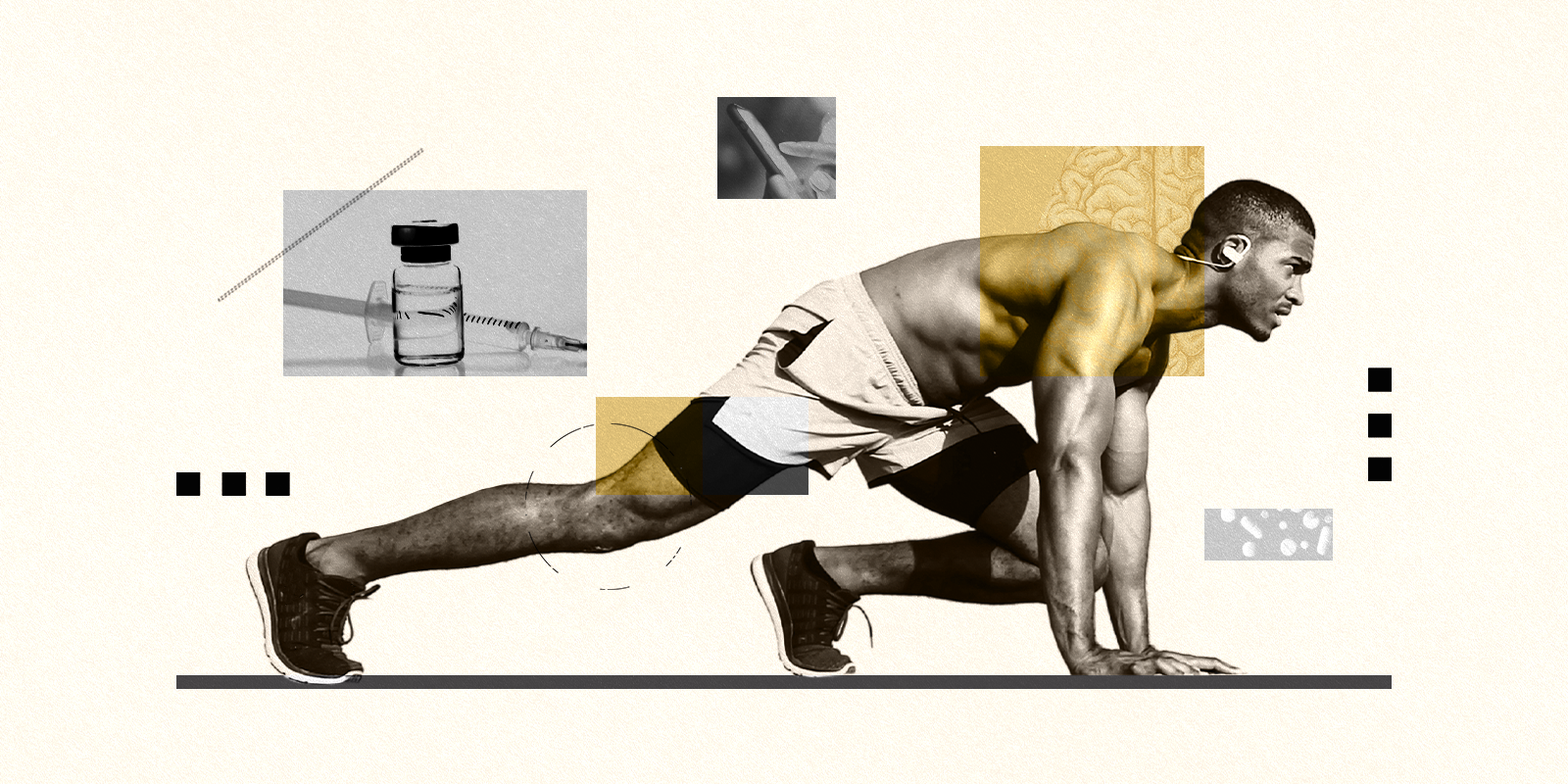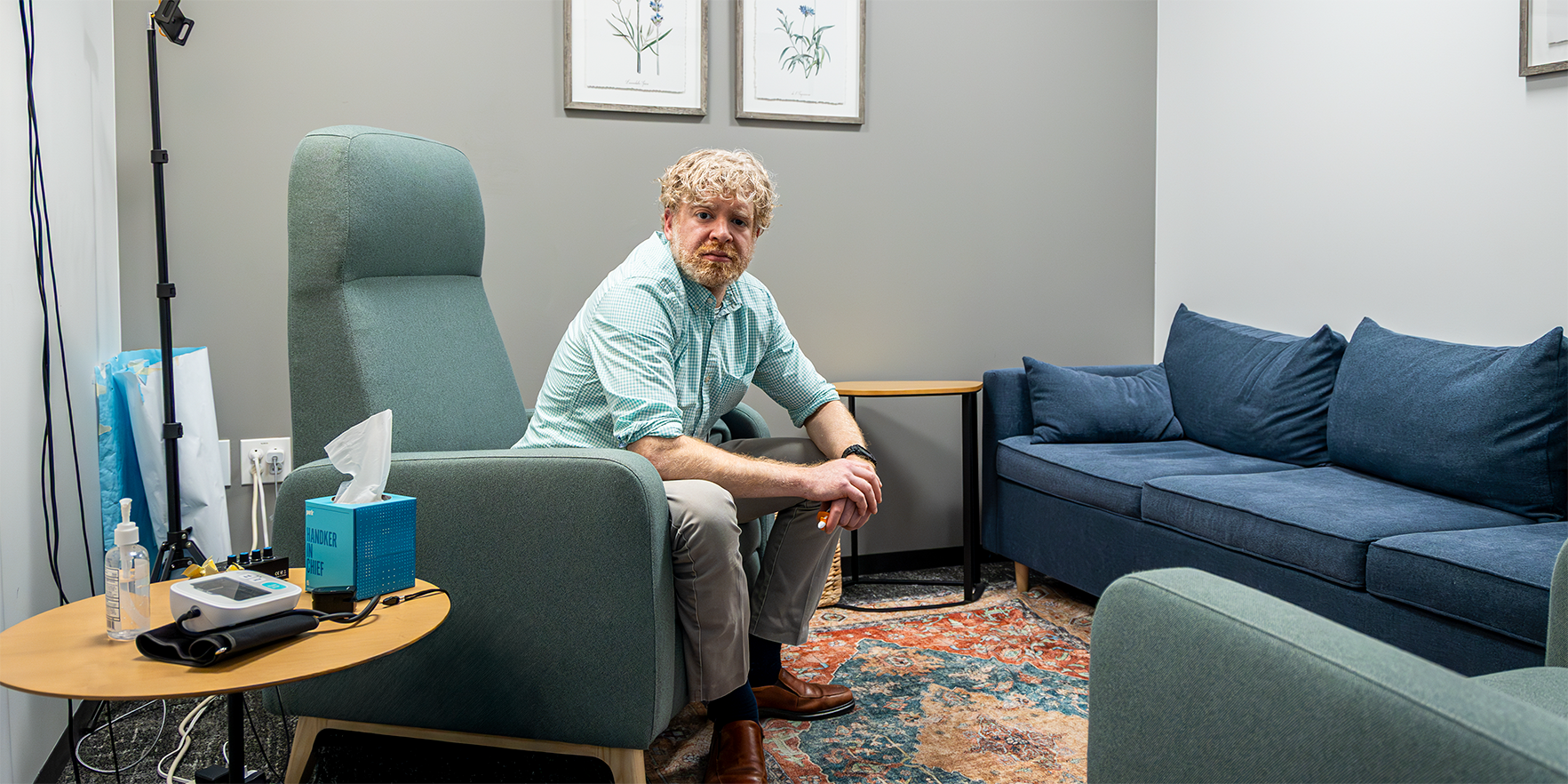While historically tied to athletes cheating in their respective sports, the specter of performance-enhancing drugs (PEDs) has found its way into local gyms and youth athletics. As the scope of PED use grows, so do healthcare provider concerns, as problems associated with the dangerous drugs spill into their practices.
An estimated 3 million to 4 million Americans use unregulated and unsupervised PEDs – more than the number of U.S. patients with type 1 diabetes. However, the estimate is likely a significant undercount. Federal health agencies do not keep statistics on adult PEDs use – in contrast to other illicit drugs – leaving researchers and providers to approximate the problem’s scope.
“PED use is probably more widespread than we would assume,” said Derek Stokes, assistant professor and sports medicine physician in the Department of Physical Medicine and Rehabilitation at the CU School of Medicine. “I would say that it's problematic and it's a significant growing public health concern, not only in competitive athletes, with much of the media attention focusing on those stories, but also in recreational athletes at your local gym and even high school student athletes.”
As their use expands, understanding the perplexing world of PEDs – which include far more than steroids – is critical for users, providers and parents. The multi-billion-dollar industry raises significant mental and physical health concerns, preys on people through social media and fuels negative body image issues, experts say.
What are PEDs and are they safe?
“I think when people hear ‘steroids’ or ‘PEDs,’ they think of exogenous – external and supplemental – testosterone, but it can actually encompass several drugs,” said Ben Hill, PharmD, an assistant professor in the Department of Clinical Pharmacy at the Skaggs School of Pharmacy and Pharmaceutical Sciences.
“For example, in shooting sports or archery, they would consider a beta blocker a performance-enhancing drug. They have a medical use in treating heart conditions, but they can also be used to slow the heart rate to make shooting easier and more accurate.”
From anabolic steroids to insulin, the scale and diversity of drugs and products used to promote muscle growth and enhance image are numerous and evolving, making staying updated a continual struggle for experts.
PEDs: Controlled substances
All testosterone-based products and anabolic steroids are listed as Schedule III drugs under the Controlled Substances Act. That means providers can prescribe only limited amounts at a time and all refills require written approval. Possession without a prescription is also illegal, carrying fines and potential incarceration depending on the offense. Trafficking the drugs brings stiffer penalties. The United States has also made periodic updates to legislation regarding PEDs, which last expanded in 2014.
“Our scientific understanding is being outpaced by the clinical or public use of these PEDs,” Stokes said. “Scientists are working as fast as possible, but we also need to make sure that providers, including primary care physicians and pediatricians, have adequate educational exposure to these topics to identify risk behaviors in patients early on.”
Because many PEDs are produced in murky, underground markets, users have little insight into safety or ingredient integrity, whether they buy products online or through “medical spas or clinics” that offer compounded versions.
“Unless you have specific high-quality tests being done on those products,” Hill said, “you can never say for sure what you're going to be receiving or putting into your body, on top of risking infection through injectable drugs. A fancy website doesn’t mean it is reputable, especially if it is advertising that you can bypass your doctor and all these regulations.”
PED Examples & Descriptions
A wide and growing range of drugs and supplements can be classified as performance or image enhancers. Ben Hill, PharmD, an assistant professor in the Department of Clinical Pharmacy at the Skaggs School of Pharmacy and Pharmaceutical Sciences, provides a rundown of some major categories.
Synthetic steroidal androgens that were originally developed to have a greater anabolic to androgenic effect than testosterone.
Anabolic refers to tissue and muscle building, while androgenic refers to sex hormones – testosterone stimulates the development and maintenance of male characteristics. They were on the market and sold over the counter until 2004, when the Anabolic Steroid Control Act classified the products as controlled substances with significant health risks to the population. Types include oral 17-alpha-alkylated androgens (such as stanozolol) or parenteral 19-nortestosterone derivatives (such as nandrolone).
A combination of products taken together in a specific manner.
For example, if someone wants to build leaner muscle mass, they might have a peptide stack that contains some form of fat burner and a muscle growth product. There are a variety of products out there, all with unique functions. These can include other medications, supplements or herbal products to “achieve” that specific goal.
Nonsteroidal products that bind to androgen receptors in select locations such as the muscle and bone.
They are not considered steroids but target the same receptors. SARMs are used to help promote muscle and bone strengthening while reducing the effects on sexual organs. Dozens of varieties are out there. However, it is important to stress these are not authorized for sale but for research purposes. As such, an underground market exists, leading to people using them without FDA approval or confirming they are appropriate for them to use individually.
Insulin-based products developed as diabetes treatment.
These products are being abused in order to promote glucose transport into the musculature and out of the blood. This carries some significant risks to the individual, especially if they are not monitoring their blood glucose levels. Low blood glucose levels or hypoglycemia can increase the risk of fainting, dizziness/lightheadedness, sweating, shakiness or blurry vision. If too much is injected, it can cause seizures, unconsciousness or coma. All insulin products are different and have different absorption rates and onset. For example, a long-acting insulin can last in the body for 24 hours where the fast-acting will be 1-3 hours.
Insulin-like growth factor.
A peptide hormone produced by the liver in response to the growth hormone that is important for growth development.
A long-lasting bronchodilator (helps expand the lungs).
It is approved for use in horses but not in humans due to significant cardiovascular and neurological side effects. It comes in the form of syrup, tablets and liquid for injection. Side effects include heart palpitations, muscle tremors and nervousness. It activates the body to increase lean muscle mass and reduce body fat.
A protein-based hormone produced by the pituitary gland.
It helps promote growth, metabolism and body development. It is not a steroid because it does not have the same carbon structure as testosterone.
Prescription products commonly prescribed to females with a history of hormone-positive breast cancer.
They carry serious risk/side effects that, if not properly monitored, can be very dangerous, such as blood clots and stroke.
Products that purportedly increase testosterone sensitivity or production.
They are not well-supported by robust evidence. Many of the products fail to significantly increase serum testosterone levels, including eurycoma longifolia – an herbal extract commonly marketed to boost testosterone. Rigorous studies have not been conducted to show clinical efficacy for use on these products. Other products that might be marketed as improving testosterone in the body include Zinc, vitamin D, Fenugreek, Ashwagandha, Tribulus terrestris, L-arginine and D-aspartic acid with similar questionable efficacy.
PED terminology
PED users have a series of colloquial terms for the drugs and their use:
- Stacking: using a combination of drugs and supplements simultaneously to further push bodies to achieve a response (while also increasing health risks).
- Cycling: switching on and off from one PED to another to give the body breaks from a single PED.
- Pyramiding: gradually increasing dosage amounts.

A shrouded problem boosted by social media
The reasons behind the high use of these dangerous products are multifaceted, according to Emily Hemendinger, MPH, LCSW, an assistant professor of psychiatry at the CU School of Medicine. But they center around a societal conception that ties worth to physical appearance – a notion that technology has made inescapable, she said.
“Our algorithms are flooded with influencers, athletes and other public figures selling the latest supplements to lose weight, enhance our cognitive functioning or even reverse aging. They are touting the supposed benefits of these drugs without understanding the dangers they pose.”
When existing emotional issues are combined with use, it creates “a perfect storm,” Hemendinger said.
“These drugs are frequently used by people who are unhappy with their appearance, have lower self-esteem and self-worth, and who may have co-occurring mental health conditions,” Hemendinger said. Many users consider more traditional efforts – exercise combined with diet and nutrition – insufficient or too slow, she said.
PED use poses widespread physical risks
The list of PEDs’ potential physical effects is long and can ultimately spiral from “mild” headaches and nausea to strokes and cancer. The products are even more dangerous in youth.
“From a pediatric standpoint specifically, premature growth-plate closure can be an issue, which will stunt height development,” Stokes said. “Delays to puberty can cause big issues, and rapid muscle gain on developing bodies can overload the tendinous points leading to significant injuries.”
Environmental factors, such as Colorado’s high altitudes, can also play a role in physical effects from PEDs, Hill said. Testosterone or synthetic testosterone can increase red blood cell count, especially hemoglobin and hematocrit, he said. “If you start thickening your blood, you’re at a higher risk of having a clot form that can induce heart attacks or strokes, especially at altitude.”
In her practice, Alice Barnes, PT, DPT, SCS, sees another group that might be interested in PEDs: those recovering from a sports injury.
A medical need, but dangerous availability
Despite the raft of online vendors (many underground) for performance-enhancing drugs, some products (such as testosterone) still have a medical purpose for patients when taken under supervision and with the right testing support. For example, low testosterone in those of male-born sex could trigger decreased libido, sexual dysfunctions, depressive episodes, tiredness or fatigue.
He emphasized: Several FDA-approved testosterone-boosting drugs are sourced from reputable providers and help fix an underlying condition to get a patient back to a healthy baseline. “Those with low testosterone undergo regular lab monitoring to avoid these side effects,” Hill said. “Taking these drugs without talking to your primary care provider can lead to a risk of pretty detrimental side effects when you are at a normal level of testosterone.”
A significant challenge for healthcare providers, however, is the ease of access and attendant opportunities for misuse.
“I just got on Google last night and typed in various anabolic steroids and clicked shop,” said Derek Stokes, assistant professor of physical medicine and rehabilitation at the CU School of Medicine. “These could ship directly to me without any input from a medical professional. It’s a big issue because this is a wild west of unregulated sources combined with an ease of access.”
“I see adolescent and adult athletes at our practice, from those on their high school teams to those running the Leadville 100 and professional organizations such as the U.S. Tennis Association,” said Barnes, a lecturer and associated faculty member in the University of Colorado Physical Therapy Program, who specializes in sports and athletic physical therapy.
“After an injury, the conversation ends up being, ‘Well, how do I get back faster?’ And as providers, we have to help ask patients important questions around: ‘How are you fueling? What does your nutrient timing look like? What types of foods are you putting into your body?’ We have to tell patients they can’t rely on these products for recovery or enhancement.”
A snapshot of some of the common side effects for common PEDs, including anabolic steroids, selective androgen receptor modulators, peptide and human growth hormone, androstenedione, stimulants, clenbuterol and blood doping:
- Acne and permanent acne scarring
- Addiction potential
- Aggression and violent tendencies
- Arthritis
- Anxiety
- Cancer
- Cardiovascular risks – high blood pressure, stroke, heart attack, poor blood flow, heart palpitations, ventricular hypertrophy (a thickening of the heart’s lower chambers)
- Carpal tunnel syndrome
- Depression
- Diabetes and blood sugar impacts
- Facial bloating
- Fluid retention issues
- Headaches
- Heatstroke
- Hormonal disruptions
- Impacts to cholesterol – increases in LDL (bad cholesterol); decreases in HDL (good cholesterol)
- Infections from non-sterile injection materials
- Irritability and mood swings
- Kidney damage and failure
- Liver damage and failure
- More frequent colds
- Mood swings
- Muscle tremors
- Nervousness
- Nausea
- Pulmonary embolism
- Sexual effects for men and women – such as baldness, voice changes, impacts to reproductive organs, including infertility and menstrual irregularities.
- Sleeping difficulties
- Tendon and ligament damage
- Thyroid problems
- Vision impacts
Another scenario Barnes sees: When PEDs themselves lead to injuries. “A lot of times with PEDs, you may see an immediate response. However, you’re going to have an overall decrease in your lean muscle mass as it gets broken down, which opens the door for injuries. If you combine that with a false sense of security when it comes to unsustainable and fast increases in strength, endurance, recovery and other physical abilities, you might be at a further risk of injury when you are supposed to “cycle” off these drugs ” she said.

PEDs can create a heavy mental load
“We need to take a step back and think a lot about the long-term health impacts – both physical and mental – in order to address this issue,” Stokes said. “On the mental health side, there’s such a potential for a larger pattern of impulsive and risk-taking behavior – alongside illicit drug use, especially in young males.”
Hemendinger agreed, and said the risks of PEDs only exacerbate existing mental health issues and do not address the underlying conditions. “Use of these drugs can be related to body image distress, perfectionism and eating disorders, all of which will only worsen with the continued use. The same can be said for aggression, irritation, depression and anxiety,” she said.
Since these drugs can affect the neurotransmitter pathways in the brain, sleep patterns, movement, emotions, appetite, sexuality and learning are all impacted, Hemendinger said. All these changes stack up while the root cause or reason for taking PEDs in the first place could be reduced and better addressed by speaking with a therapist or psychiatrist, she said.
Fighting back against marketing
While it can be difficult to avoid falling for PED marketing tactics and influences, Hemendinger says there are a few steps to take to practice body acceptance and neutrality. First step, balancing your social media use and realizing when those feeds aren’t serving you.
“You have to start by acknowledging that our culture is obsessed with appearance, winning, and achievement,” Hemendinger said. “Focusing on those things won’t help you in the long run. From there, recognizing when you are being critical of your body and performance and naming those as thoughts, not the truth, while practicing what you are grateful for with your body to shift the function of exercise to less around physical appearance and letting go of comparisons to other ‘ideal’ bodies.
Stokes emphasized that education about PEDs is even more important for youth – and that support networks of parents and peers play an essential role in their behaviors.
“With younger populations, a lot of times it’s peer pressure and normalization around these drugs,” Stokes said. “There’s a thinking of invincibility, that these side effects and growth and development delays won’t happen to them. So we need the coaches and adults in their lives to be present and a safe outlet. Role models alongside peer support are huge in stopping these behaviors.”
Experts: Solutions lie in trust and guidance for better long term health
So how can providers, coaches and parents help? Have open, honest and non-judgmental discussions about PED use and body acceptance, the experts said.
“We’re movement specialists,” Barnes said. “How do we help our patients think about the way we move, take care of their bodies and reach their goals in a healthy and sustainable way?” Conversations should include everything from protein timing and training schedules to integrating mental health support during recovery, she said.
And open conversations, whether it’s providers or parents, must include listening, Stokes said. “It is important to explore why they are using PEDs. What are their goals? Strength? Self-esteem? Performance? Knowing that can be key to understanding how to guide them to healthier and safer pathways for those same goals.”
Barnes has one such patient she started such a conversation with.
“I have an adult athlete that had a bilateral quad tear that was sent to the hospital for rhabdomyolysis – a serious injury where your muscles break down and toxic pieces of your muscle fiber can enter your bloodstream,” Barnes said.
“He sustained this injury playing pickleball, which is uncommon. After looking at his lab numbers, we had to have a conversation asking, ‘Are you cycling on and off steroids? That’s going to affect your tendon health. I think that's great that you feel strong and look great at the gym, but is it functional? You're a dad of three. You have to be able to run around with your kids.’"







